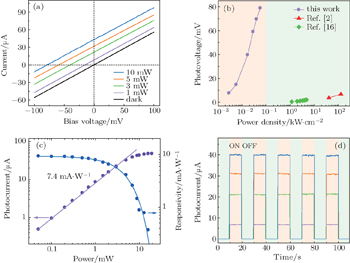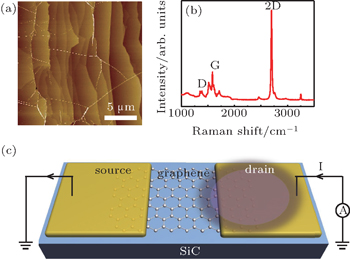† Corresponding author. E-mail:
‡ Corresponding author. E-mail:
Project supported by the National Key Basic Research Program of China (Grant Nos. 2011CB932700 and 2013CBA01603) and the National Natural Science Foundation of China (Grant Nos. 51472265 and 51272279).
A self-powered graphene-based photodetector with high performance is particularly useful for device miniaturization and to save energy. Here, we report a graphene/silicon carbide (SiC)-based self-powered ultraviolet photodetector that exhibits a current responsivity of 7.4 mA/W with a response frequency of over a megahertz under 325-nm laser irradiation. The built-in photovoltage of the photodetector is about four orders of magnitude higher than previously reported results for similar devices. These favorable properties are ascribed to the ingenious device design using the combined advantages of graphene and SiC, two terminal electrodes, and asymmetric light irradiation on one of the electrodes. Importantly, the photon energy is larger than the band gap of SiC. This self-powered photodetector is compatible with modern semiconductor technology and shows potential for applications in ultraviolet imaging and graphene-based integrated circuits.
Graphene is a promising material for ultrafast and ultra-broadband photodetection[1–8] because of its high carrier mobility[9] and broadband optical absorption.[10] Among reported graphene photodetectors, those with a self-powered photoelectric response[2,11–13] are particularly useful for device miniaturization and to save energy in integrated circuits. However, the reported self-powered photodetectors usually suffer from low photocurrent responsivity[11–13] because of the weak optical absorption of monolayer graphene[10] and ultrafast photogenerated carrier recombination in graphene[7,8] or a weak photothermoelectric effect.[14–16] Therefore, developing a self-powered graphene-based photodetector with high performance is highly desired, yet it remains a great challenge.
To realize an enhanced photoresponse under zero bias, two fundamental premises need to be satisfied simultaneously. One is to produce a large photovoltage between the electrodes, and the other is to enhance the non-equilibrium carrier density in graphene.[2,7,17] Regarding the former, a few studies on the photothermoelectric effect and very small photovoltaic responses of self-powered photodetectors have been reported.[1,2,16] In terms of the latter, various prototype devices involving integration of either quantum dots (QDs)[18] or an optical cavity[19] with graphene have already been demonstrated. However, both the QD and optical cavity-assisted routes are too complicated to meet the requirements of large-scale fabrication. Therefore, a simple device preparation procedure combined with a mature technique for advanced graphene production suitable for large-scale fabrication sensitive photodetectors is desirable. The potential of epitaxial graphene (EG) on silicon carbide (SiC) as a material for integrated electronic devices has been demonstrated.[20,21] If the advantages of graphene and SiC can be combined in a special device design consisting of a simple metal–graphene–metal structure with two-terminal electrodes exposed asymmetrically to ultraviolet (UV) light, a high-performance graphene-based UV photodetector without power supply may be obtained. Such a UV photodetector could find applications in both military and civilian fields.[22–24]
There are a few reports concerning the use of EG on SiC in photodetectors.[16,25,26] However, in the reported results, either the photon energy was deliberately smaller than the band gap of the SiC substrate to avoid influence from SiC[16] in a simple two-terminal graphene device, or a Schottky junction was used, where carriers in the circuit loop had to overcome the Schottky barrier between graphene and SiC, resulting in high power consumption.[26] Here, we demonstrate a graphene/SiC-based self-powered UV photodetector that exhibits a photocurrent responsivity of 7.4 mA/W with a response frequency of over megahertz under asymmetric 325-nm laser irradiation of one of the electrodes. The photogenerated carriers in SiC transfer to the irradiated electrode under the driving of interface field, so that a photovoltage of dozens of millivolts is built up between the electrodes with and without light irradiation. The built-in photovoltage responsivity is about four orders of magnitude higher than that of previously reported graphene-based photodetectors.[2,16] This graphene photovoltaic device or photodetector is compatible with modern semiconductor technology, making it attractive for use in UV imaging and graphene-based integrated circuits.
EG was obtained by graphitization of SiC in H2/Ar atmosphere at about 1350 °C. The growth of few-layer graphene (layer number of less than ten) on SiC was identified by atomic force microscopy (AFM) (Multimode 8.0 from Bruker) observation (Fig.
The device structure and measurement electrical circuit are illustrated in Fig.
Figure
The dependences of photocurrent and responsivity of the device on laser power were extracted (Fig.
 | Fig. 2. (a) Current versus source–drain bias under different UV light irradiation power. (b) Dependence of photovoltage on irradiated light power density in this work, along with results reported in Refs. [2] and [16]. (c) Extracted photocurrent and responsivity as a function of incident light power. (d) Photocurrent responses at zero bias under on/off (yellow/green time scales) switching of UV light with powers of 1, 3, 5, and 10 mW (from bottom to top). |
The external quantum efficiency (EQE, ηe) for photon conversion into conducting electrons can be derived from the equation:[5]

Besides the stable photocurrent response, the temporal photocurrent responses at zero bias voltage under on/off switching of UV light of different powers are depicted in Fig.
To understand the origins of the impressive photovoltage of this UV photodetector and the mechanism of its photoresponse, energy band diagrams of the heterojunctions between graphene, SiC, and metal Ti are depicted in Fig.
In summary, an extraordinary graphene/SiC UV photodetector was proposed and demonstrated. The device is a simple metal–graphene–metal structure that combines the advantages of the ultrahigh carrier mobility of graphene and effective UV light absorption of SiC, together with the device design entailing asymmetric UV light irradiation of only one of the electrodes. The asymmetric UV irradiation of one of the electrodes produces a photovoltage allowing sensitive UV signal detection. The highest photocurrent responsivity of the device is 7.4 mA/W, and its response frequency is faster than a megahertz with high stability. The device fabrication procedure is compatible with modern semiconductor technology, and it is easy to achieve multi-pixel arrays, making this device highly competitive as a solution for future UV imaging and integration with other graphene-based electronic devices.
| 1 | |
| 2 | |
| 3 | |
| 4 | |
| 5 | |
| 6 | |
| 7 | |
| 8 | |
| 9 | |
| 10 | |
| 11 | |
| 12 | |
| 13 | |
| 14 | |
| 15 | |
| 16 | |
| 17 | |
| 18 | |
| 19 | |
| 20 | |
| 21 | |
| 22 | |
| 23 | |
| 24 | |
| 25 | |
| 26 | |
| 27 | |
| 28 | |
| 29 | |
| 30 |




